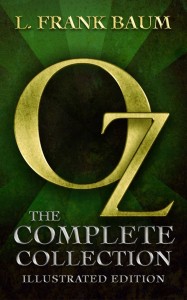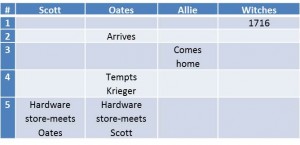I had a fan I met at the LA Times Festival of Books drop me a note asking about my self publishing experience. I thought I’d share the reply in case anyone else had the same questions. You can check it out here.
Category: Uncategorized
I read THE WIZARD OF OZ last week. I’ve seen the movie a dozen-plus times growing up, watched James Franco’s prequel, even saw THE WIZ on Broadway as a kid, but the time had come to travel to the literary headwaters and experience the source. I bought the complete Frank L. Baum collection of Oz tales for 99 cents on my Kindle.
This book isn’t the MGM musical. All the familiar characters are there: Tin Woodsman, Cowardly Lion, Wicked Witch, etc. They embark on the same quest to Oz. But the path is quite different, through many different lands, with far more challenges. Interestingly enough, in this version, the Great and Powerful tells all four individually that he will give each their wish if they kill Witchy Poo. It’s assigned as a solo task. They decide to collaborate on their own.
This is a children’s story, written at the turn of the 20th Century, and it reads that way. No casting stones on that account. In my head, I imagined reading it aloud to the right age group of kids, and I’m certain that it would still work.
It’s Dorothy who doesn’t. A more passive and undeserving character would be hard to come by. Her killing of the Wicked Witch of the East is accidental. She pulls the Scarecrow from his post, oils the Tin Woodsman to life, and, well, humiliates the poor Lion with a swat on the nose. But past these self-serving actions, she adds no value to the group, takes almost no action at all until she waters the Wicked Witch to death. The Woodsman makes quick work of some attacking trees, the Scarecrow defends Dorothy and Toto from a murder of crows, the Lion kills an enormous spider. Dorothy? Nada. She demands food and shelter from any convenient house they pass, makes sure to wash her face every day, and spends so much time in the background during action scenes that you wonder why the Lion was the one deemed cowardly. When the Wizard of Oz tells her that she has to kill the Wicked Witch to earn a ride home, she pouts and cries, as if the ruler of the Emerald City owes her transportation just for the asking. And how does she return home in the end? Just wish for it. No wonder Auntie Em shut the storm cellar door with little Dot on the outside.
My critique group took me to task for this same error in my manuscript for Q ISLAND. I let a main character be the consistent recipient of rescue. My painfully honest Beta readers hated her, just as I was ready for the attacking trees to rip off Dorothy’s arms, because neither character had earned our sympathy. They need to try, and especially try and fail, for the reader to root for them to win. If a character doesn’t make some kind of effort, the reader sure isn’t going to.
Baum does reward the three real heroes. The Scarecrow replaces the balloon-hijacked Wizard. The Lion gets to succeed a dead lion as King of the Beasts in a section of the forest. The Woodsman is acclaimed leader of the Winkies once their enslavement under the Wicked Witch ends.
Now that I write that, all the folks in Oz look like they prefer some sort of totalitarian state to self-rule. I wonder if these three transitions will work about as well as Vladimir Putin taking the wheel from Boris Yeltsin?
Time to hit the rest of those Oz books.
This is my 1968 Camaro convertible. I rescued her from outside Wichita. Her name is Dorothy because she isn’t in Kansas anymore. And yes, this post will eventually be about writing.
Now you may look at Dorothy as a candidate for the junkyard. And yes, she needs some work. Well, she needs almost everything. But she has nice options like a power top and a manual transmission. And most important, she has a good frame, the rails that support the car. I can put new fenders, a new top, and new floorboards on a good frame. Without a strong frame, the car would collapse on itself, no matter how many new parts I added.
Along with resurrecting a car, I’m resurrecting a manuscript. It’s not as old as Dorothy, but it’s from a while ago. I re-read the synopsis, remembered how enthusiastic I was writing it, and thought it had promise.
It became slow going. Apparently, I thought adverbs were wonderful back them. When writing monologues, seems I confused “internal” with “Interminable.” I’ve cut so many redundant passages that the 90,000 word novel is verging on novella. After four tedious hours where the story bored even me, I considered giving up and working on one of the new ideas always sitting in queue.
The time had come for the seat-of-the pants writer to turn outliner. This always happens to me, usually about two-thirds into the manuscript. I need to make sure the threads are all weaving into some coherent pattern. I went through each chapter and summarized the main action and what characters were involved. I like to put it in a table like the example below:
This way I can follow multiple, overlapping plotlines, like Chapter 5 where Scott and Oates meet.
After looking over the chart, I decided to stick with it. Like Dorothy, the story has a good frame, but here it’s called plot.
So why am I bored by it? Characters without fire, without connection, are killing it. I can fix that. In this action-driven paranormal thriller, that will be the equivalent of swapping out Dorothy’s fenders and recovering her seats. Plot problems, like a rust-weakened frame, requires so much re-writing, I’d rather just start something else that stirred new passion.
If a story isn’t feeling right, take the time to ensure the plot clicks. It is a lot easier for those of you who outline compared to pantsers like myself. By the way, this is an example of why my advice is don’t be a pantser. Way too time consuming, with lots of writing dead ends. I read an interview with a prolific author who said he used to be a pantser and had to switch methods to keep his volume up.
Back to work. Two projects to finish. Of the two, Dorothy might take a little longer.
TMI for Authors? Maybe.
New technology delivers instant answers. Google knows how many people live in International Falls, MN (6376 in 2011). IMBD know who played Nick the Bartender in It’s a Wonderful Life (Sheldon Leonard). There are more recipes for chocolate cake out there than anyone can eat in a lifetime.
Authors have benefited from the advent of the Information Age. Sales figures are available in near real time. To be properly impressed by this, you have to understand the previous system. In that one, a bookstore bought a book and, sometime in the next ninety days, paid for that book and it registered as a true sale. The store could also return the book for credit, even before the ninety days are up, which allowed the wonderful experience of negative sales figures. These figures were tallied and given to the author in a quarterly report along, in a good quarter, with a royalty check. Using these sales reports to describe real time sales was about as effective as using Neolithic cave paintings to determine current weather.
Now Book Scan tells you daily sales, and even charts them. Novel Rank gives you a close sales approximation for Amazon. (How cool to see “Last sale: 0 hours.”) Amazon updates Kindle sales figures and every book’s ranking throughout the day. I’m certain there are even more systems available to publishers, but these are the ones even self-published authors have access to.
Great progress, right? Hell no. Writing is a profession rife with rejection. Agents reject your queries. Magazines reject your flash fiction. Editors reject your novels. If by some miracle of talent and timing, you survive that gauntlet, you still have the chance to be rejected by readers. In the old days you could be bummed out once, then have ninety days to rebuild your sense of self-worth before the enduring another kick to the head. Now you can find out how few people appreciate your hard work every sixty minutes. That doesn’t leave a lot of recharge time. Watching a slow selling book every hour is like playing every game of keno at Harrah’s dawn to dusk without winning.
Sales wax and wane. They also usually miss expectations, mostly because we set expectations high. (Even bestselling authors probably look at sales and say, “What, only 28,000 copies sold this week?”) Chill about the numbers, and confine yourself to one update a week. The summary reveals more than the fluctuating individual days do, anyway.
Spend your time writing. After all, which feels better, reading that your book moved up two in the Amazon ranking, or reading your newly-minted descriptive paragraph that paints a perfect picture? The creative process is what keeps us motivated. The thrill of summoning a story out of thin air lasts longer and runs stronger than the one any sales figures can summon.
Last week, I came across an excellent example of poor character creation, and its impact.
 By the nature of our lifestyles, my wife and I DVR a lot and then get caught up later, so forgive me for being behind the curve on this. We were just getting caught up on Grimm, a show about a cop with unique talents who hunts criminal human/animal hybrids. In this episode, a new character was introduced, a young woman who also had his special ability.
By the nature of our lifestyles, my wife and I DVR a lot and then get caught up later, so forgive me for being behind the curve on this. We were just getting caught up on Grimm, a show about a cop with unique talents who hunts criminal human/animal hybrids. In this episode, a new character was introduced, a young woman who also had his special ability.
Half an hour in, the character had demonstrated that she was rude, unappreciative, combative and self-centered. I said to my wife, “I already hate this new character.” To my surprise, she answered, “I agree. We can stop watching this anytime you want.” She hated her enough to switch the program off.
We’re big Grimm fans, but both of us were ready to bail on the show because of this new addition to the cast. That’s exactly the opposite of the response a writer shoots for. Obviously, this character was being set up for some change arc across episodes, but I didn’t care to see it. The cops filled me in on her foster care childhood and I’d seen her attacked by the bad guys, yet I had no compassion for her. Why? Because while she’d been in sympathetic circumstances, she’d displayed no sympathetic qualities. A character has to do at least one small thing like wash the dishes or rescue a cat from a tree so viewers can see there’s a real human being inside her that deserves their emotional energy.
I think her impact on the other characters in the show made it even worse. Nick, our hero cop, and his girlfriend take her in, then Nick takes her to a crime scene (credibility stretched past breaking) where she nearly reveals his secret gift. In a lame bit of dialogue, Nick addresses her by her given name and she responds that most people call her Trouble. So Nick calls her that from then on. It sounds stupid every time he says it, and no caring person would reinforce another’s low self-esteem with such a nickname. So not only was the character unlikable, she had a negative impact on how we saw the characters we do like, onscreen friends we are emotionally invested in.
We skipped the rest of that episode, and the next one, praying that either Trouble would die or hurry-the-hell-up and finish her transformation, an event we couldn’t care less about witnessing. Her part in the season finale looked like she’d made it.
The TV series didn’t lose us for good, mostly because my wife is a Monroe/Rosalie devotee. But in a book, this kind of mistake would be fatal. The cover would close, never be reopened, and the reader would send out warning flares for the rest of the world to stay far away. So keep in mind that that character who goes from flawed to fabulous, or that villain who goes from evil to excellent, needs a little something for us to hook onto early, something to foreshadow their potential, to make us root for the underdog part of their personality to win out.



